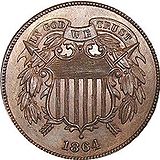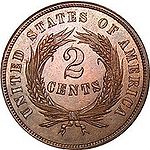.gif)
Two-cent piece (United States coin)
Encyclopedia
| Two-Cent | |
| Value: | 2 cents (0.02 U.S. dollars United States dollar The United States dollar , also referred to as the American dollar, is the official currency of the United States of America. It is divided into 100 smaller units called cents or pennies.... ) |
| Mass: | 6.221 g |
| Diameter: | 23.00 mm |
| Thickness: | ? mm |
| Edge: | plain |
| Composition: | 95% Cu Copper Copper is a chemical element with the symbol Cu and atomic number 29. It is a ductile metal with very high thermal and electrical conductivity. Pure copper is soft and malleable; an exposed surface has a reddish-orange tarnish... , 5% Zn Zinc Zinc , or spelter , is a metallic chemical element; it has the symbol Zn and atomic number 30. It is the first element in group 12 of the periodic table. Zinc is, in some respects, chemically similar to magnesium, because its ion is of similar size and its only common oxidation state is +2... & Sn Tin Tin is a chemical element with the symbol Sn and atomic number 50. It is a main group metal in group 14 of the periodic table. Tin shows chemical similarity to both neighboring group 14 elements, germanium and lead and has two possible oxidation states, +2 and the slightly more stable +4... |
| Obverse | |
 |
|
| Design: | Shield |
| Designer: | James Barton Longacre James Barton Longacre James Barton Longacre was an American engraver, who was the fourth Chief Engraver of the United States Mint from 1844 until his death. He succeeded Christian Gobrecht in the position as Chief Engraver upon Gobrecht's death... |
| Design Date: | 1864 |
| Reverse | |
 |
|
| Design: | Wreath |
| Designer: | James Barton Longacre James Barton Longacre James Barton Longacre was an American engraver, who was the fourth Chief Engraver of the United States Mint from 1844 until his death. He succeeded Christian Gobrecht in the position as Chief Engraver upon Gobrecht's death... |
| Design Date: | 1864 |
The two-cent coin was produced in the United States
United States
The United States of America is a federal constitutional republic comprising fifty states and a federal district...
from 1864–1873 with decreasing mintages throughout that time. In terms of consumer price indexes, the 1864 coin would be comparable to $ in today's money.
The two-cent piece was authorized by Congress
United States Congress
The United States Congress is the bicameral legislature of the federal government of the United States, consisting of the Senate and the House of Representatives. The Congress meets in the United States Capitol in Washington, D.C....
on April 22, 1864 by the Coinage Act
Coinage Act (1864)
The Coinage Act of 1864, a United States federal law, changed the composition of the one-cent coin and authorized the minting of the two-cent coin...
. The same law also eliminated the half dime
Half dime
The half dime, or half disme, was a silver coin, valued at five cents, formerly minted in the United States.Some numismatists consider the denomination to be the first coin minted by the United States Mint under the Coinage Act of 1792, with production beginning on or about July 1792...
and the silver three-cent piece (the copper-nickel three cent piece continued to be minted through 1889). During the mid- and late-1970s there was some discussion about reviving the two-cent denomination (in conjunction with reducing the mintage of the one-cent piece), but nothing came of it.
Two-cent pieces were minted in both proof
Proof coinage
Proof coinage means special early samples of a coin issue, historically made for checking the dies and for archival purposes, but nowadays often struck in greater numbers specially for coin collectors . Many countries now issue them....
and regular issues. Although the proof mintages were normally smaller than the regular issue mintages, more proofs of high grade survive as they were always considered special collector coins.
While all two-cent pieces are of the same type, many die varieties exist. The most significant of these are the Small Motto and Large Motto varieties of 1864. The Small Motto is rarer and more valuable. Doubled die
Doubled die
Doubled die is a term in numismatics used to refer to doubling in the design elements of a coin. Doubled dies can appear as an outline of the design or in extreme cases, having legends and dates appear twice in an overlapping fashion....
s, die cracks and other mint error
Mint-made errors
Mint-made errors are errors in a coin made by the mint during the minting process. Mint error coins can be the result of deterioration of the minting equipment, accidents or malfunctions during the minting process, or intentional interventions by mint personnel...
s are often encountered in this series.
Design & Composition
The two-cent piece was designed by James B. Longacre, the Chief Engraver of the United States MintUnited States Mint
The United States Mint primarily produces circulating coinage for the United States to conduct its trade and commerce. The Mint was created by Congress with the Coinage Act of 1792, and placed within the Department of State...
, and was the first coin of the United States to bear the motto "In God We Trust
In God We Trust
"In God We Trust" was adopted as the official motto of the United States in 1956. It is also the motto of the U.S. state of Florida. The Legality of this motto has been questioned because of the United States Constitution forbidding the government to make any law respecting the establishment of a...
." The design is similar to the shield nickel
Shield nickel
The Shield nickel was the first United States five cent piece to be made out of copper-nickel, the same alloy of which American nickels are struck today. Designed by James B. Longacre, the coin was issued from 1866 until 1883, when it was replaced by the Liberty Head nickel...
of the same period, which was also designed by Longacre.
The obverse (so designated because it bears the date) has a shield with a ribbon over it bearing the motto, IN GOD WE TRUST. Behind the shield are two arrows, and a branch with leaves (most likely an olive branch).
The reverse has a wreath made up of several different plant components surrounding the words 2 CENTS. The words UNITED STATES OF AMERICA surround the wreath.
The two-cent piece was made of 95% copper with tin and zinc making up the remainder. It was just slightly smaller than a modern U.S. quarter.
Mintage Figures
All two-cent pieces were minted at the Philadelphia Mint, and therefore bore no mint mark.- 1864 - 19,847,500
- 1865 - 13,640,000
- 1866 - 3,177,000
- 1867 - 2,938,750
- 1868 - 2,803,750
- 1869 - 1,546,500
- 1870 - 861,250
- 1871 - 721,250
- 1872 - 65,000
- 1873 - About 1,000 (proof only)
External links
- US Two-Cent Piece by year and type. Histories, photos, and more.
- Two-Cent pictures
- PCGS article on two-cent pieces with reference to proposed late 20th century revival of this coin type

